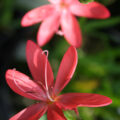by Sally Gregson.
Now, a few weeks and months after the last fiery breaths of the drought, it’s time to take a salutary look back at the situation in the garden. The heat and desiccating winds have left a legacy of poorly plants. Some trees lost their leaves rather too soon, while others have simply died.
A quick way of working out which parts of a seemingly dead tree are merely biding their time, is to use the thumbnail test. Scratch a centimetre of skin off the top of a brown stem. Is it brown underneath? Try halfway up the length of the branch. Is it brown underneath? And then, as a last hope, scratch the top skin off the lower limbs or branches. Is it still brown underneath? This exercise repeated all over will give you an idea of the living shape of what remains. If the conclusion is negative, and the tree is doomed, dig it out completely, removing as much of the root structure as possible. Only then turn buckets-full of garden compost into the hole.
And then find a new tree. In these long, dark evenings it is a pleasure to trawl through the websites and catalogues to find a tree which will tolerate the given conditions. Be careful to analyse exactly whether the soil is basically heavy clay, loam, or free-draining sand.
October is the ideal time to plant a tree, especially in light, sandy soils – it will/should be watered naturally throughout the winter and get itself established. In heavy soils, it’s better to wait until spring when the soil is not waterlogged and is beginning to warm up. Loam soil is a gardener’s delight – it can be worked at any time during the winter.
In light soils, including loam, cherries and almonds enjoy drier roots. For heavy soils it might be better to consider crab apples, Sorbus commixta or hollies. Check your choice online, especially favouring the RHS website for accurate information.
Another important factor is the amount of light and shade a tree will tolerate. Acers, Cercidiphyllum and Cornus are happy in light shade. And Yew – Taxus baccata – will grow away in draining soil in dark shade.
Dig a big hole, at least twice the size of the root-ball of the bare-root tree; position it in the hole at the same depth it was potted; place a stout stake at a slanting angle into the prevailing wind and tie it in; back fill with the soil and compost and water it very well immediately and every dry week or two.
Its roots will steadily move out into its new home, and it will leaf up next spring to bring you joy.









Leave a Reply